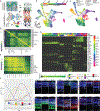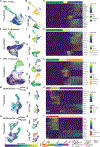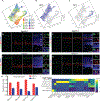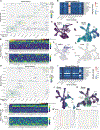Single-Cell Analysis of Human Retina Identifies Evolutionarily Conserved and Species-Specific Mechanisms Controlling Development
- PMID: 32386599
- PMCID: PMC8015270
- DOI: 10.1016/j.devcel.2020.04.009
Single-Cell Analysis of Human Retina Identifies Evolutionarily Conserved and Species-Specific Mechanisms Controlling Development
Abstract
The development of single-cell RNA sequencing (scRNA-seq) has allowed high-resolution analysis of cell-type diversity and transcriptional networks controlling cell-fate specification. To identify the transcriptional networks governing human retinal development, we performed scRNA-seq analysis on 16 time points from developing retina as well as four early stages of retinal organoid differentiation. We identified evolutionarily conserved patterns of gene expression during retinal progenitor maturation and specification of all seven major retinal cell types. Furthermore, we identified gene-expression differences between developing macula and periphery and between distinct populations of horizontal cells. We also identified species-specific patterns of gene expression during human and mouse retinal development. Finally, we identified an unexpected role for ATOH7 expression in regulation of photoreceptor specification during late retinogenesis. These results provide a roadmap to future studies of human retinal development and may help guide the design of cell-based therapies for treating retinal dystrophies.
Keywords: cell fate; fovea; gene regulatory networks; neurogenesis; neurogenic bHLH factor; organoid; patterning; retina; single cell RNA-seq; transcription factors.
Copyright © 2020 Elsevier Inc. All rights reserved.
Conflict of interest statement
Declaration of Interests The authors declare no competing interests.
Figures







References
-
- Ayyaz A, Kumar S, Sangiorgi B, Ghoshal B, Gosio J, Ouladan S, Fink M, Barutcu S, Trcka D, Shen J, et al. (2019). Single-cell transcriptomes of the regenerating intestine reveal a revival stem cell. Nature 569, 121–125. - PubMed
Publication types
MeSH terms
Substances
Grants and funding
LinkOut - more resources
Full Text Sources
Other Literature Sources
Molecular Biology Databases

